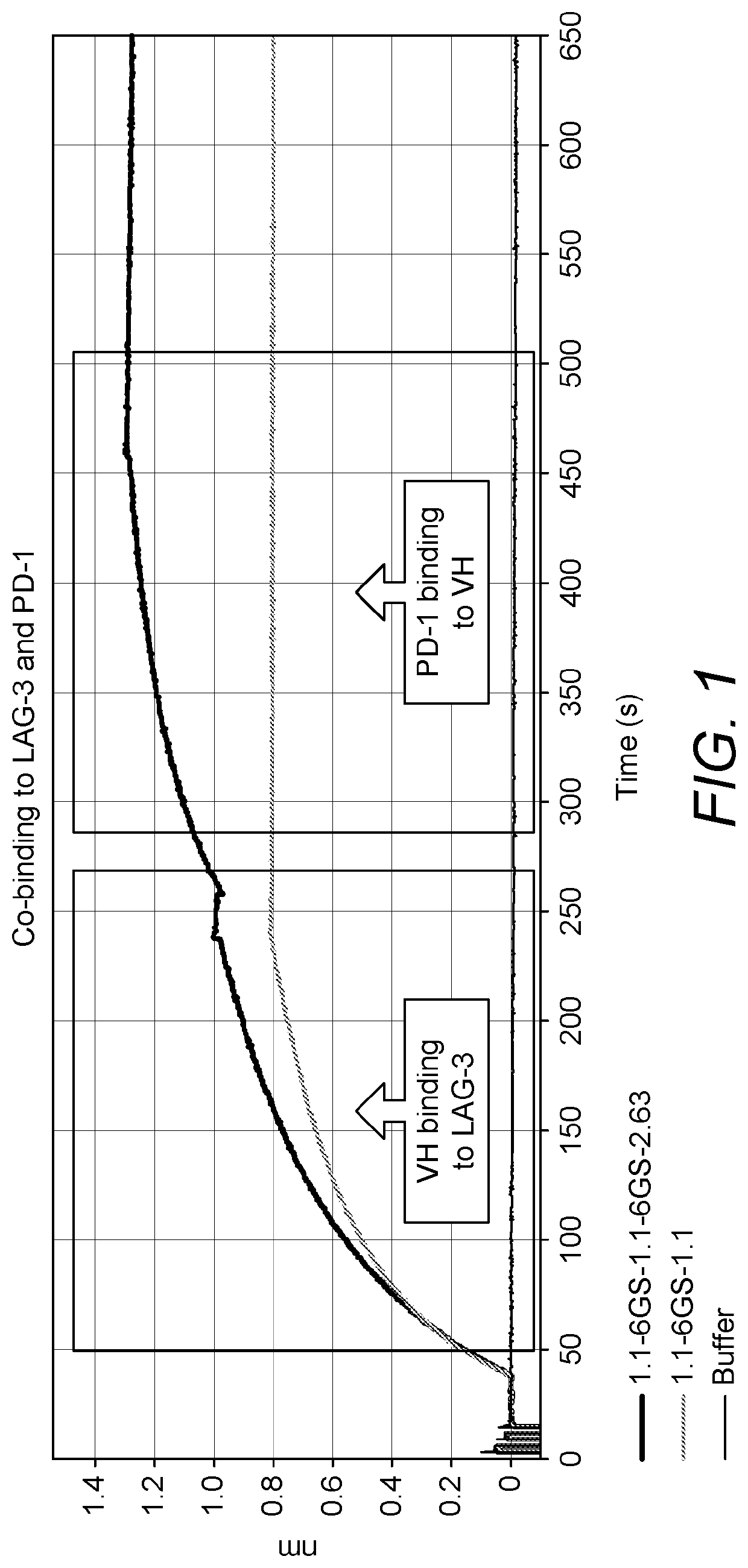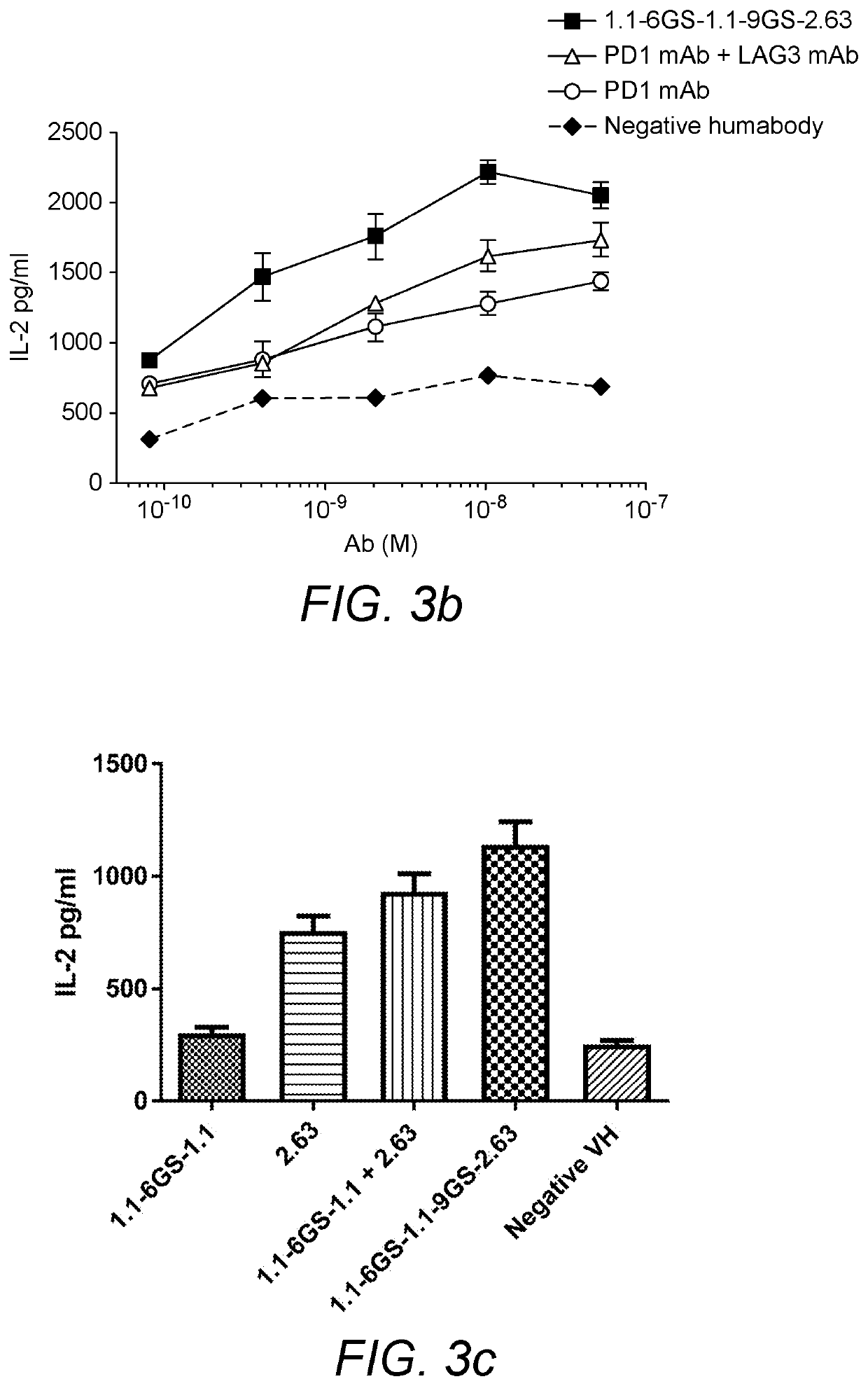Therapeutic molecules that bind to lag3 and pd1
a technology of lag3 and pd1, applied in the field of therapeutic molecules, can solve the problem of low response rate and other problems
- Summary
- Abstract
- Description
- Claims
- Application Information
AI Technical Summary
Benefits of technology
Problems solved by technology
Method used
Image
Examples
example 1
ion of Tg / TKO Mice
[0280]Mice carrying a human heavy-chain antibody transgenic locus in germline configuration within a background that is silenced for endogenous heavy and light chain antibody expression (triple knock-out, or TKO) were created as previously described (WO2004 / 076618, WO2003 / 000737, Ren et al., Genomics, 84, 686, 2004; Zou et al., J. Immunol., 170, 1354, 2003 and WO2016 / 062990). Briefly, transgenic mice were derived following pronuclear microinjection of freshly fertilised oocytes with a yeast artificial chromosome (YAC) comprising a plethora of human VH, D and J genes in combination with mouse immunoglobulin constant region genes lacking CH1 domains, mouse enhancer and regulatory regions. Yeast artificial chromosomes (YACs) are vectors that can be employed for the cloning of very large DNA inserts in yeast. As well as comprising all three cis-acting structural elements essential for behaving like natural yeast chromosomes (an autonomously replicating sequence (ARS), ...
example 2
or Immunisation and Characterisation
LAG-3
[0283]Human and monkey LAG-3 extracellular domains were made as IgG fusion proteins for immunisation of transgenic mice or for binding studies. Human LAG-3 sequence accession NM_002286. Rhesus LAG-3 accession XM_001108923. The amino acid sequence for Rhesus monkey matches that of Cynomolgus monkey for LAG3 domains 1-3 (NC_022282). Mouse LAG3 was from R&D Biotechne (cat 3328-L3). Human LAG-3 domains 1-4 and 1-2 were cloned using standard molecular biology techniques. Domains were identified as per Huard et al 1997 PNAS 94:5744-9. Expression was performed in HEK 293 cells and the LAG3 proteins were purified using size exclusion chromatography. Chinese Hamster Ovary (CHO) cells expressing human LAG-3 were generated using the human LAG-3 sequence within an inducible expression vector. The plasmid was transfected using lipofection and stable cell pool selected with antibiotics. Cells expressing LAG-3 were sorted based on positive binding of mouse ...
example 3
ion Protocol
[0285]Tg / TKO mice aged 8-12 weeks of age each received an initial prime dose of 40 μg of recombinant purified human LAG-3-Fc protein emulsified in Complete Freund's Adjuvant and delivered subcutaneously, followed by three boosts of 10 μg of the recombinant protein, emulsified in Incomplete Freund's Adjuvant, also administered subcutaneously, given at various intervals following the initial priming. A final dose of 20 μg recombinant purified human LAG-3-Fc protein antigen was administered intraperitoneally, in phosphate buffered saline, in the absence of adjuvant.
[0286]For immunisations to generate PD-1 blockers, Tg / TKO mice aged 8-12 weeks of age each received an initial prime dose of either 50 μg or 10 μg of recombinant purified human PD-1-Fc protein
PUM
 Login to View More
Login to View More Abstract
Description
Claims
Application Information
 Login to View More
Login to View More - R&D
- Intellectual Property
- Life Sciences
- Materials
- Tech Scout
- Unparalleled Data Quality
- Higher Quality Content
- 60% Fewer Hallucinations
Browse by: Latest US Patents, China's latest patents, Technical Efficacy Thesaurus, Application Domain, Technology Topic, Popular Technical Reports.
© 2025 PatSnap. All rights reserved.Legal|Privacy policy|Modern Slavery Act Transparency Statement|Sitemap|About US| Contact US: help@patsnap.com



